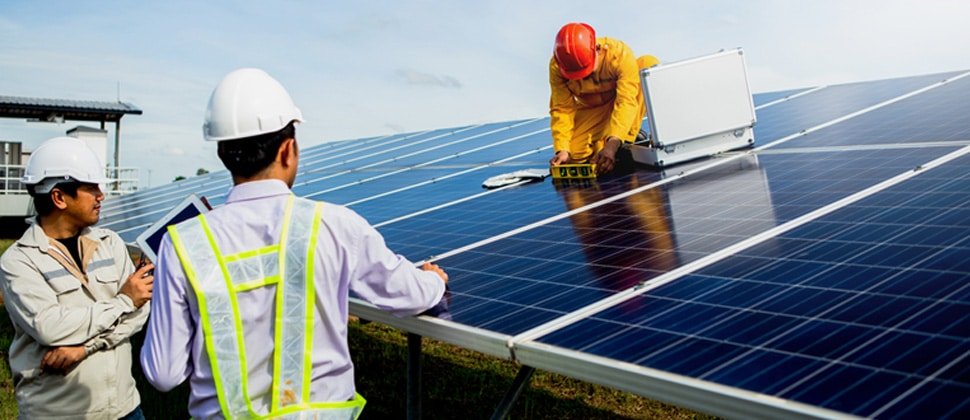August 12, 2022

Although solar energy is becoming increasingly popular, it’s still a relatively new phenomenon for the average energy consumer. So, in our latest blog, we’re sharing 19 solar energy facts you probably didn’t know. Whether solar energy is entirely new to you or you consider yourself a renewable energy fanatic, these facts about solar are sure to surprise you. So, let’s get into it!
That’s right, for thousands of years, the sun has been an essential resource to humanity. From heating and cooking to heating our homes, the power of solar energy is like no other.
Despite being around for a long time, solar energy technology didn’t have its time to shine until 1954. It wasn’t until then that Bell Laboratories created the first commercially viable solar cell; the rest is history.
The scale of the solar power opportunity is insane. In fact, there’s enough sunlight hitting the Earth every hour to meet the entire world’s power needs for a year.
If the Mojave Desert – which is 124,000 km² – was covered with solar panels, they would generate over twice the amount of electricity used in the United States every year.
It cost a staggering £65 per watt for a simple solar cell back in 1977. Today, according to the Solar Energy Industries Association, the cost of a solar cell is just £0.18, falling by 99% in the past 45 years.
Guess what? Access to sunlight is entirely free, abundant, and accessible to everyone. In less than 10 minutes, light can travel an astonishing 90 million miles to Earth from the sun, and it happens all day, every day.
Minus minimal pollution produced during the manufacturing process, solar power is undoubtedly one of the world’s most sustainable and cleanest energy sources.
As we tackle rising energy costs and inflation, solar power could save you as much as £300 annually on your energy bill, according to the treasury. Furthermore, any excess energy from your solar installation can be sold to the National Grid and will earn you money.
Generally, a new solar power plant is backed by a power purchase agreement with a customer for a duration of 20 to 25 years. However, that doesn’t render the power plants worthless after this period.
The infrastructure surrounding a solar power plant boasts plenty of potential. For example, old solar panels could be replaced with new modules at a relatively low cost. Therefore, developing a solar power plant is a long-term and highly efficient investment.
Thanks to increased efficiency and decreased cost, solar power has quickly become the preferred form of new electricity across the globe. According to PV Magazine, Solar contributed 28% of the U.K.’s total renewable energy generation in 2021, as growth in renewable energy solutions has increased by 6.9% since 2010 to a new record high.
No other electricity source can be repaired or built as quickly as solar if disaster strikes. We’ve seen it first-hand after Puerto Rico was devastated by Hurricane Maria in 2017. As reported by BBC News, Tesla and others built a small solar power plant complete with energy storage within a matter of weeks. Other renewable energy sources and fossil-fuel power plants would take considerably longer to develop.
Over the years, studies have shown that investing in a solar panel installation can increase the resale value of your home. Of course, the figure is often dependent on location, but generally speaking, you can expect a solar set-up to add a couple of thousand pounds to the value of your home.
When maintained, you can expect your solar panels to last for decades, with many providers offering an impressive 25-year warranty.
Perhaps one of the more surprising facts on this list is that the space industry adopted solar technology in the early 1950s. For more than 50 years, solar has been used to provide power for spacecraft.
The Vanguard1 was the first satellite to use solar cells to generate power. Today, the Vanguard1 remains the oldest manmade satellite currently still orbiting, racking up over six billion miles.
While many people know solar energy can power electric vehicles (EVs), trains and more transport, you may not know that it can also power planes. Solar-powered planes can fly around the world using purely solar energy.
In 2016, Swiss explorer and pilot Bertrand Piccard departed from Abu Dhabi on Solar Impulse II, a solar-powered aircraft. Powered entirely by solar power, Bertrand successfully completed a global flight.
Thanks to the ease of installation and an abundance of light, solar power is a go-to source for temporary use. Over the years, the Olympic games, mining sites and more have transported and installed solar panels at various temporary locations for a reliable and accessible energy source.
Thanks to solar storage systems, you can use solar power even when it’s dark, overcast, or cloudy. By attaching a battery to your solar panel system, you can store energy for later use. Because of this, you can power your home 24/7, meaning you’ll enjoy reduced reliance on the grid.
With environmental pressures rising each year, installing solar panels means you can power your home without contributing to harmful emissions and greenhouse gases – two significant contributors to global warming. The Energy Saving trust shared that a typical households solar panel system could save around 1.3 to 1.6 tonnes of carbon every year, dependent on your location in the U.K.
In April 2022, the U.K. Government announced that the reduced VAT rate of 5% on solar panels had been scrapped. The good news? The rate has been further reduced to 0% to support households to boost their energy efficiency and reduce costs. The VAT-free period will run until March 2027 before returning to 5%.
As mentioned previously, when you’re generating and storing your own power, you’ll reduce your reliance on the National Grid to power your home. As a result, you’ll enjoy less reliance on the national grid, reducing your energy bills.
